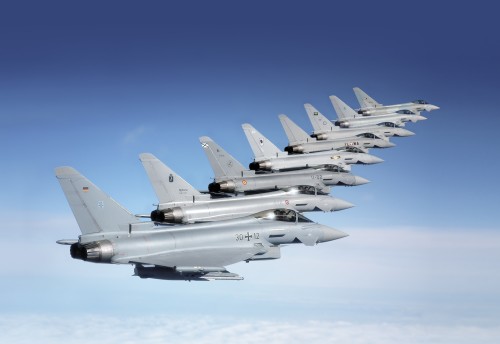The Eurofighter Typhoon is undergoing a significant modernisation to ensure its continued dominance in the face of ever-evolving threats. The heart of this upgrade is a next-generation electronic warfare (EW) system, poised to extend the aircraft’s operational life to 2060 and beyond. This new system, built upon the legacy of the existing “Praetorian” Defensive Aids Sub-System (DASS), promises to catapult the Eurofighter into a new era of electronic dominance.

The current Praetorian system, named after the elite Roman bodyguard corps, has served the Eurofighter admirably for over 30 years, protecting it from a multitude of threats, including heat-seeking and radar-guided missiles. The new EW system, however, represents a significant leap forward, integrating seamlessly as a form-fit retrofit option, eliminating the need for any modifications to the aircraft’s external structure. This innovative design ensures a smooth transition for both new and existing Typhoons, minimising aircraft clearance issues.
This enhanced EW suite is not just an incremental improvement, but a radical departure, harnessing cutting-edge technologies to provide the Eurofighter with unparalleled capabilities in the increasingly complex battlespace. At the core of this transformation is the integration of advanced complex threat characterisation, enabling the aircraft to swiftly and accurately assess the nature of hostile threats. The system also incorporates Digital Radio Frequency Memory (DRFM), a potent tool for jamming enemy radar systems, effectively blinding adversaries. Moreover, the wideband Active Electronically Scanned Array (AESA) Electronic Counter-Measures (ECM) provides the Eurofighter with a formidable shield, boosting its self-protection with increased power. Finally, the provision of interfaces for an external, high-powered electronic attack pod significantly enhances the Eurofighter’s ability to conduct Suppression of Enemy Air Defence (SEAD) missions – a critical requirement for NATO operations.
Perhaps the most groundbreaking aspect of this upgrade is its data-centric architecture, a testament to the developers’ foresight in anticipating the rapidly evolving nature of airborne threats. This forward-looking design incorporates a high-speed, high-bandwidth infrastructure, capable of rapidly transmitting raw signal data to a sophisticated central processing hub. The sheer volume of data processed would overwhelm human operators, necessitating the inclusion of Cognitive Electronic Warfare (CEW). This cutting-edge technology leverages the power of AI and machine learning to analyse the vast amounts of high-fidelity data gathered by the system, enabling the Eurofighter to adapt to emerging threats in real time.
This sophisticated data processing capability transforms the battlespace for Eurofighter pilots, providing them with an unparalleled level of situational awareness. They can now identify and prioritise multiple complex threats simultaneously, and at extended ranges, making the Eurofighter a far more lethal and survivable platform in contested airspace.
The development of this game-changing EW system is a testament to the collaborative spirit of European defence cooperation. The EuroDASS consortium, comprising industry leaders Leonardo, ELT Group, Indra, and Hensoldt, brings together a wealth of experience and expertise in electronic warfare. Working in close partnership with systems integrator BAE Systems, they are spearheading this crucial upgrade as part of the ambitious Typhoon Next Generation initiative.
The next-generation EW system marks a significant step forward in the evolution of the Eurofighter Typhoon, solidifying its position as a premier combat aircraft. This upgrade, born from cutting-edge technology, a data-centric design philosophy, and a collaborative development approach, ensures that the Eurofighter will continue to dominate the skies, meeting the challenges of the future with confidence and unwavering capability.
For more information, hit the Source below
We should persuade European owners of Euro fighters to donate one Eurofighter to the Udvar Hazy Museum instead of scrapping it.